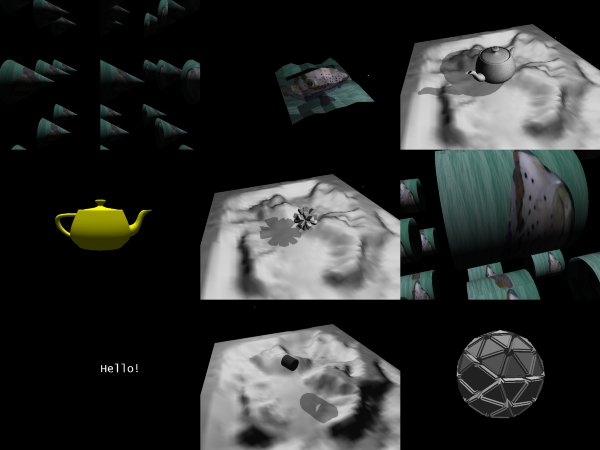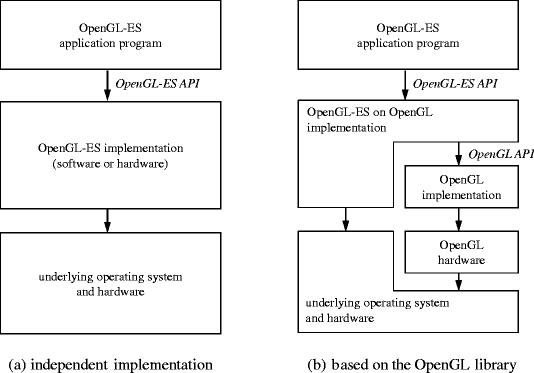NVIDIA provides OpenGL-accelerated Remote Desktop for GeForce. Adobe zii illustrator 24.3. In these days of social distancing, game developers and content creators all over the world are working from home and asking for help using Windows Remote Desktop streaming with the OpenGL tools they use. OpenGL Utility Library. The OpenGL Utility (GLU) library contains several groups of functions that complement the core OpenGL interface by providing support for auxiliary features. These utility functions make use of core OpenGL functions, so any OpenGL implementation is guaranteed to support the utility functions.
There are numerous Windowing system and interface libraries available for OpenGL as well as Scengraphs and High-level libraries build on top of OpenGL
- About GLUT
- GLUT is the OpenGL Utility Toolkit, a window system independent toolkit for writing OpenGL programs. It implements a simple windowing application programming interface (API) for OpenGL. GLUT makes it considerably easier to learn about and explore OpenGL Programming.
- Other GLUT-like Window System Toolkits
- Libraries that are modeled on the functionality of GLUT providing support for things like: windowing and events, user input, menuing, full screen rendering, performance timing
- About GLX, GLU & DRI
- GLX is used on Unix OpenGL implementation to manage interaction with the X Window System and to encode OpenGL onto the X protocol stream for remote rendering. GLU is the OpenGL Utility Library. This is a set of functions to create texture mipmaps from a base image, map coordinates between screen and object space, and draw quadric surfaces and NURBS. DRI is the Direct Rendering Infrastructure for coordinating the Linux kernel, X window system, 3D graphics hardware and an OpenGL-based rendering engine.
GLX, GLU and DRI
GLXLibrary
GLX 1.3 is used on Unix OpenGL implementation to manage interaction with the X Window System and to encode OpenGL onto the X protocol stream for remote rendering. It supports: pixel buffers for hardware accelerated offscreen rendering; read-only drawables for preprocessing of data in an offscreen window and direct video input; and FBConfigs, a more powerful and flexible interface for selecting frame buffer configurations underlying an OpenGL rendering window.
- Please refer to the OpenGL Registry for more information and links
GLU Library
GLU is the OpenGL Utility Library. This is a set of functions to create texture mipmaps from a base image, map coordinates between screen and object space, and draw quadric surfaces and NURBS. GLU 1.2 is the version of GLU that goes with OpenGL 1.1.
GLU 1.3 is available and includes new capabilities corresponding to new OpenGL 1.2 features.- Please refer to the OpenGL Registry for more information and links
Direct Rendering Infrastructure (DRI)
In simple terms, the DRI enables hardware-accelerated 3D graphics on Linux. More specifically, it's a software architecture for coordinating the Linux kernel, X window system, 3D graphics hardware and an OpenGL-based rendering engine.
- Higher Level Libraries built on OpenGL
- Leading software developers use OpenGL, with its robust rendering libraries, as the 2D/3D graphics foundation for higher-level APIs. Developers leverage the capabilities of OpenGL to deliver highly differentiated, yet widely supported vertical market solutions. Open Inventor, IRIS Performer, OpenGL Optimizer, OpenGL Volumizer, OpenGL Shader, Scene Graph APIs.
- Open Inventor® by VSG
- Open Inventor® by VSG is the commercial, current evolution of Open Inventor and provides an up-to-date, highly-optimized, full-featured implementation of the popular object-oriented scenegraph API for C++, .NET and Java. Applications powered by Open Inventor by VSG also benefit from powerful extensions such as VolumeViz LDM for very large volume data, MeshViz XLM for high-performance mesh support, or ScaleViz for multi-GPUs and immersive VR.
- OpenSceneGraph
- OSG is a open source high peformance 3D graphics toolkit, used by application developers in fields such as visual simulation, games, virtual reality, scientific visualization and modelling. Written entirely in Standard C++ and OpenGL it runs on all Windows platforms, OSX, Linux, IRIX, Solaris and FreeBSD operating systems.
- Quesa3D
- Quesa is a high level 3D graphics library, released as Open Source under the LGPL, which implements Apple's QuickDraw 3D API on top of OpenGL. It supports both retained and immediate mode rendering, an extensible file format, plug-in renderers, a wide range of high level geometries, hierarchical models, and a consistent and object-orientated API. Quesa currently supports Mac OS, Linux, and Windows - ports to Be and Mac OS X are in progress.
This page provides links to both general release drivers that support OpenGL 4.6, and developer beta drivers that support upcoming OpenGL features.
Release Driver Downloads
OpenGL 4.6 support is available for Windows and Linux in our general release drivers available here:
Windows
Linux
Developer Beta Driver Downloads

Windows driver version 426.02 and Linux driver version 418.52.18 provide new features for OpenGL developers to test their upcoming OpenGL applications.
Windows 426.02
Linux 418.52.18
OpenGL Beta Release Notes
NVIDIA provides full OpenGL 4.6 support and functionality on NVIDIA GeForce and Quadro graphics card with one of the following Turing, Volta, Pascal, Maxwell (first or second generation) or Kepler based GPUs:

Opengl Library Download
- TITAN: NVIDIA TITAN RTX
- GeForce RTX: GeForce RTX 2080 Ti, GeForce RTX 2080, GeForce RTX 2070, GeForce RTX 2060
- GeForce GTX: GeForce GTX 1660 Ti, GeForce GTX 1660, GeForce GTX 1650, GeForce MX250, GeForce MX230
- Quadro: Quadro RTX 8000, Quadro RTX 6000, Quadro RTX 5000, Quadro RTX 4000, Quadro RTX 3000, Quadro T2000, Quadro T1000
- TITAN: NVIDIA TITAN V
- Quadro: Quadro GV100
- TITAN: NVIDIA TITAN Xp, NVIDIA TITAN X (Pascal)
- GeForce: GeForce GTX 1080 Ti, GeForce GTX 1080, GeForce GTX 1070 Ti, GeForce GTX 1070, GeForce GTX 1060, GeForce GTX 1050 Ti, GeForce GTX 1050, GeForce GT 1030, GeForce MX150,
- Quadro: Quadro GP100, Quadro P6000, Quadro P5200, Quadro P5000, Quadro P4200, Quadro P4000, Quadro P3200, Quadro P3000, Quadro P2200, Quadro P2000, Quadro P1000, Quadro P620, Quadro P600, Quadro P520, Quadro P500, Quadro P400
- TITAN: GeForce GTX TITAN X
- GeForce: GeForce GTX 980 Ti, GeForce GTX 980, GeForce GTX 980M, GeForce GTX 970, GeForce GTX 970M, GeForce GTX 965M, GeForce GTX 960, GeForce GTX 950,
- Quadro: Quadro M6000 24GB, Quadro M6000, Quadro M5500, Quadro M5000, Quadro M5000M, Quadro M4000, Quadro M4000M, Quadro M3000M, Quadro M2200, Quadro M2000
- GeForce: GeForce GTX 960M, GeForce GTX 950M, GeForce 945M, GeForce 940MX, GeForce 930MX, GeForce 920MX, GeForce 940M, GeForce 930M, GeForce GTX 860M, GeForce GTX 850M, GeForce 845M, GeForce 840M, GeForce 830M, GeForce GTX 750 Ti, GeForce GTX 750, GeForce GTX 745, GeForce MX130
- Quadro: Quadro M2000M, Quadro M1000M, Quadro M600M, Quadro M500M, Quadro M1200, Quadro M620, Quadro M520, Quadro K2200M, Quadro K620M
- TITAN: GeForce GTX TITAN, GeForce GTX TITAN Black, GeForce GTX TITAN Z
- GeForce: GTX 780 Ti, GeForce GTX 780, GeForce GTX 770, GeForce GTX 760, GeForce GTX 760 Ti (OEM), GeForce GT 740, GeForce GT 730, GeForce GT 720, GeForce GT 710, GeForce GTX 690, GeForce GTX 680, GeForce GTX 670, GeForce GTX 660 Ti, GeForce GTX 660, GeForce GTX 650 Ti BOOST, GeForce GTX 650 Ti, GeForce GTX 650, GeForce GTX 645, GeForce GT 640, GeForce GT 635, GeForce GT 630, GeForce MX110
- Quadro: Quadro K6000, Quadro K5200, Quadro K5000, Quadro K4000, Quadro K4200, Quadro K2200, Quadro K2000, Quadro K2000D, Quadro K1200, Quadro K620, Quadro K600, Quadro K420, Quadro 410
Turing GPU Architecture
Volta GPU Architecture
Pascal GPU Architecture
Maxwell 2 GPU Architecture
Maxwell 1 GPU Architecture
Kepler GPU Architecture
The OpenGL 4.6 specifications can be downloaded from http://www.opengl.org/registry/.



For any bugs or issues, please file a bug through the developer website: https://devtalk.nvidia.com/
Turing Extensions for OpenGL
Opengl Library Functions
GPUs with the new Turing architecture have many new OpenGL extensions giving developers access to new features.
Opengl Library C++
Opengl Library C++
Release Updates
July 29th, 2019 - Windows 426.02, Linux 418.52.18
Opengl Library Download
- New: